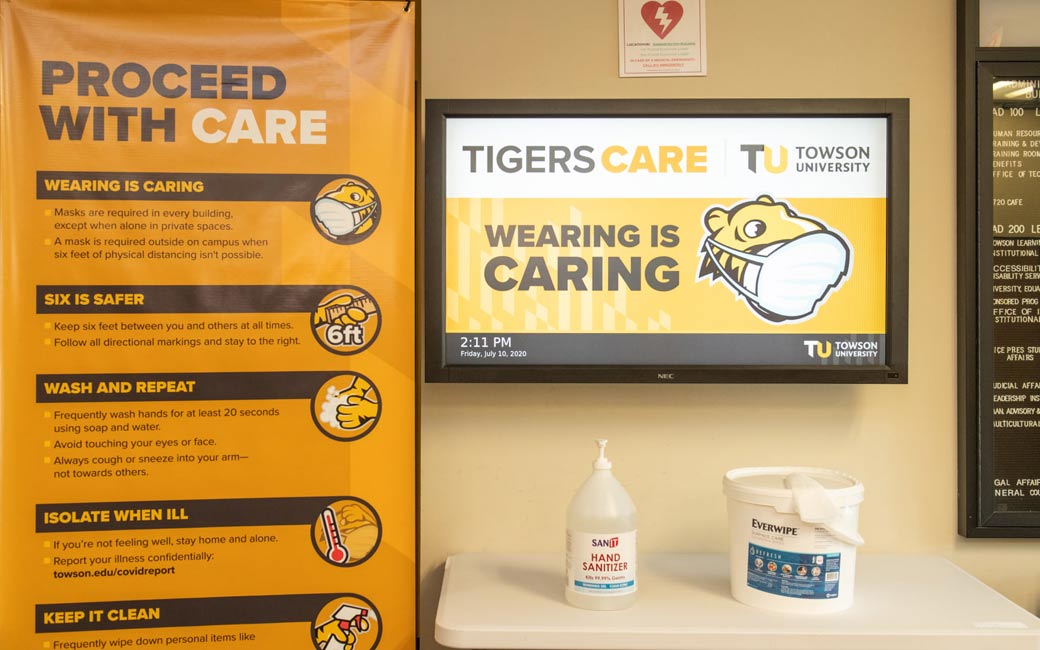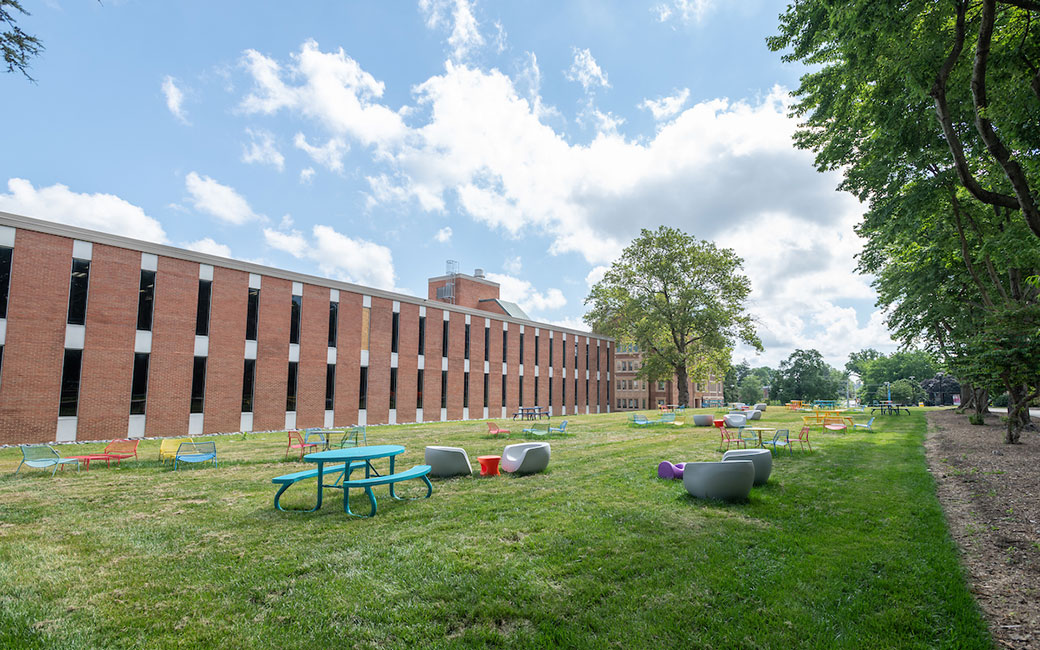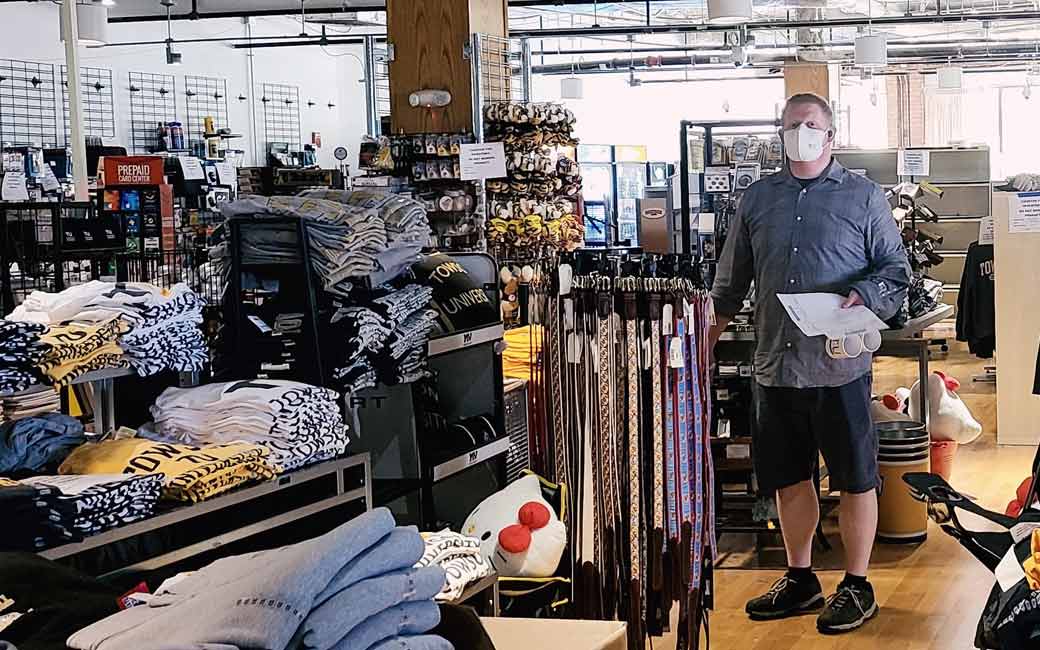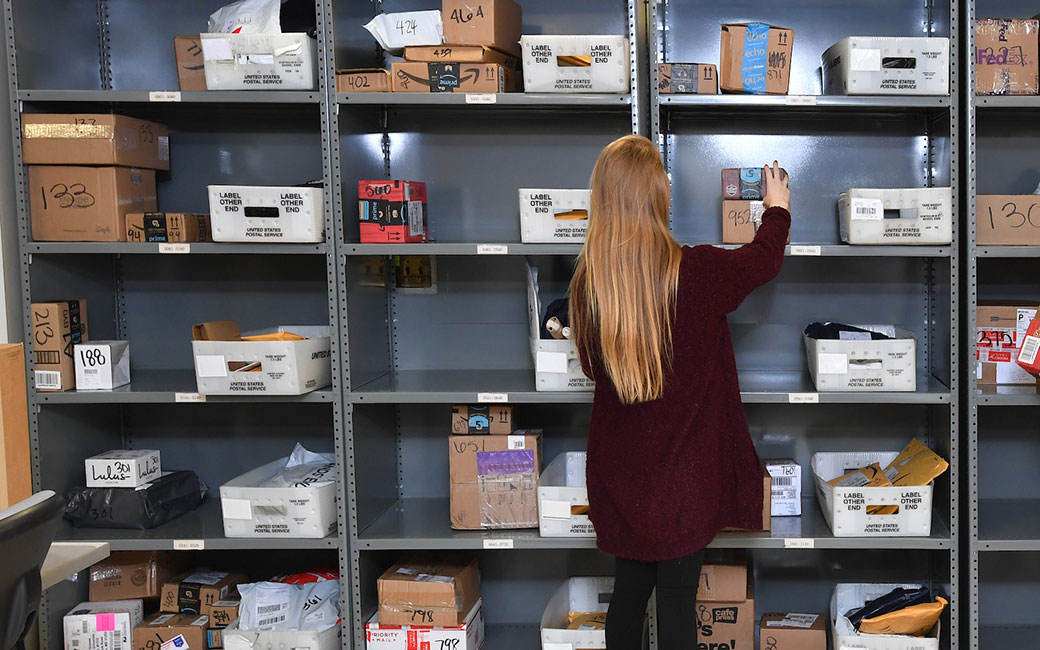
How Public Safety has prepared a safe campus
From sanitizing stations to regular patrols, the Office of Public Safety has kept campus safe and ready for the Return to TU
How Facilities Management has worked around the clock to prepare campus for the fall term

This story is part of a series on how different departments at Towson University have worked over the summer to keep operations running and prepare campus for the Return to TU.
To prepare for the Return to TU this fall, Facilities Management has been hard at work behind the scenes making campus a safe place for Tigers to learn, work and live.
While most people left campus in March, a dedicated team of facilities and ABM Janitorial Services staff jumped into action. They worked for 15 days straight preparing 185 apartments in the Residences at 10 West Burke Avenue and 90 apartments in Towson Run for potential use by Baltimore County first responders and for students that needed to remain living on campus.
They also partnered with Housing & Residence Life to coordinate a plan for students to return to campus and pick up their belongings safely. When early move-out was cut short by additional county and state gathering restrictions, a team worked to pack up and ship any remaining belongings to students that hadn’t been able to move out in person.
Thank you for sharing your understanding and pride in a difficult situation. We are in this together. #TUproud
Posted by Towson University on Sunday, April 19, 2020
“When everybody else was home worried about what was going to happen with the pandemic, our folks and ABM never left campus to get all of that done,” says Warren Riefner, director of operations and maintenance.
Once work was complete on 10 West and Towson Run, attention turned to the remaining buildings and residence halls. Operations and maintenance teams moved quickly to shut down the remaining residences for the summer.
“We were only working half of our folks in rotation to cover all the buildings and to make sure every apartment fridge was empty, the HVAC was idled down, etc.,” Riefner adds. “We’ve been busy.”
At the same time, the team had to create and implement additional safety protocols on the fly to protect staff and contract workers, as well as construction teams that continued work on projects like the new University Union and Science Complex.
As the Return to TU Task Force began planning for the safe return to campus, Facilities Management collaborated with teams across the university to realize the task force’s vision.
One important step was measuring campus buildings to determine room capacities and traffic flow according to CDC guidelines. An unprecedented situation called for unprecedented collaboration across departments, and even institutions.
“We’ve never done this, and a lot of others have never done this either,” says Terence McCann, director of planning, energy and sustainability. “We looked at CDC guidelines coming out and connected with sister institutions and other resources to collectively come up with a diagram to social distance in classrooms and control circulation.”
The team tackled classrooms first so the capacities could be delivered to the provost’s office for fall term academic planning.
With space at a premium due to physical distancing guidelines, the team got creative to find the safest areas for larger classes to meet. “We were asked to look at every available space to see what its capability is for converting to a classroom environment,” McCann says, pointing to locations including West Village Commons and even Burdick Hall.
Another priority has been finding additional outdoor spaces for physically distanced gatherings, and providing more outdoor furniture to optimize the use of outdoor spaces. “That’s another big benefit we’re going to have for when the community returns,” McCann adds.
Next Facilities Management worked with Art Services to design and print more than 25,000 signs and decals. They include interior and exterior signs, as well as directional markings in doors and hallways and capacity notices for shared spaces like bathrooms, elevators, classrooms and even shuttles. They expect to install at least 8,000 more signs in the coming weeks.
Additional safety measures include HVAC calibration and the installation of sneeze guards. Facilities Maintenance staff walked every building on campus, identifying a list of 160 high-contact areas where plexiglass should be installed. The first installations were in the bursar’s office and the checkout counter in the UStore, with additional locations to be completed by the end of July. When building coordinators return, they will have the ability to request additional plexiglass locations for review by environmental health and safety.
HVAC systems in buildings across campus have been shifted to maximize air intake. In almost all cases, there’s a 100% exchange in fresh air on a daily basis. “Because it’s monitored electronically, it’s actually detrimental to open windows,” advised Ben Lowenthal, vice president of administration and finance, during the Return to TU virtual town hall on July 9. “The air intake is monitored electronically to keep everyone as safe as possible. We ask for your cooperation to not open windows in order to maximize air intake.”
It takes a high level of cooperation across campus to make the Return to TU possible.
“Everybody has dropped whatever they were doing, and we all rowed in the same direction all summer or this couldn't possibly have happened,” Riefner says.
“This is a ton of work that’s been done on top of what we normally do every summer,” adds Kevin Petersen, associate vice president of Facilities Management. “We still have to renew each room, be ready to paint areas—it’s been a huge amount of work from all groups, and they’ve done a fantastic job.”
For more information on the operations framework for fall 2020, visit the Return to TU and coronavirus FAQ pages.

From sanitizing stations to regular patrols, the Office of Public Safety has kept campus safe and ready for the Return to TU

Store staff secures course material, prepares physical shop for customers

Neither rain nor sleet nor COVID-19 will keep postal services from its rounds